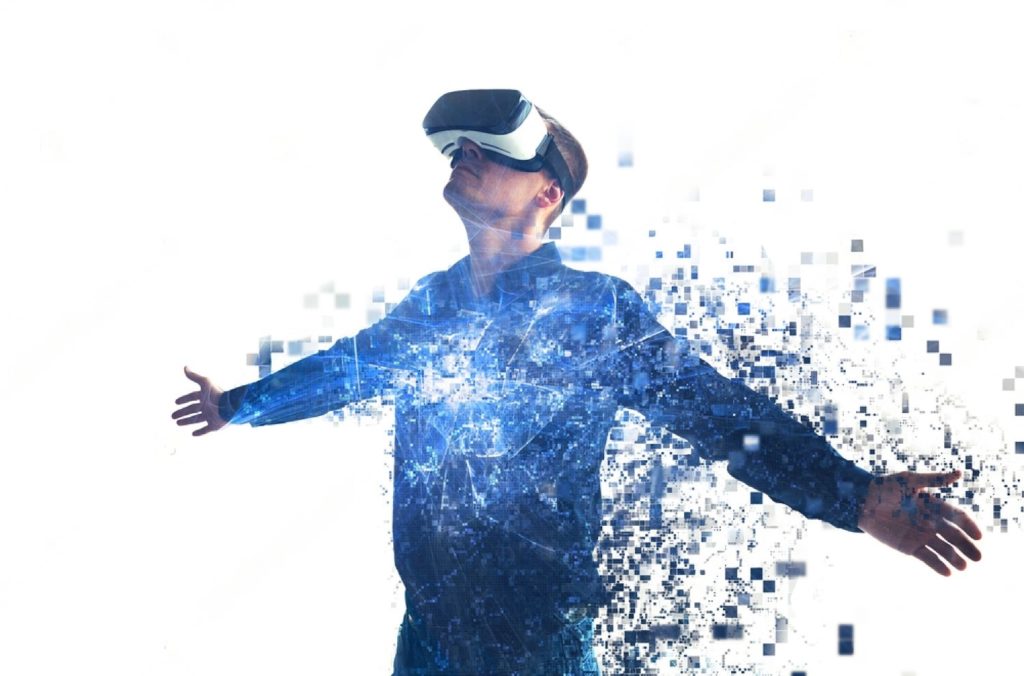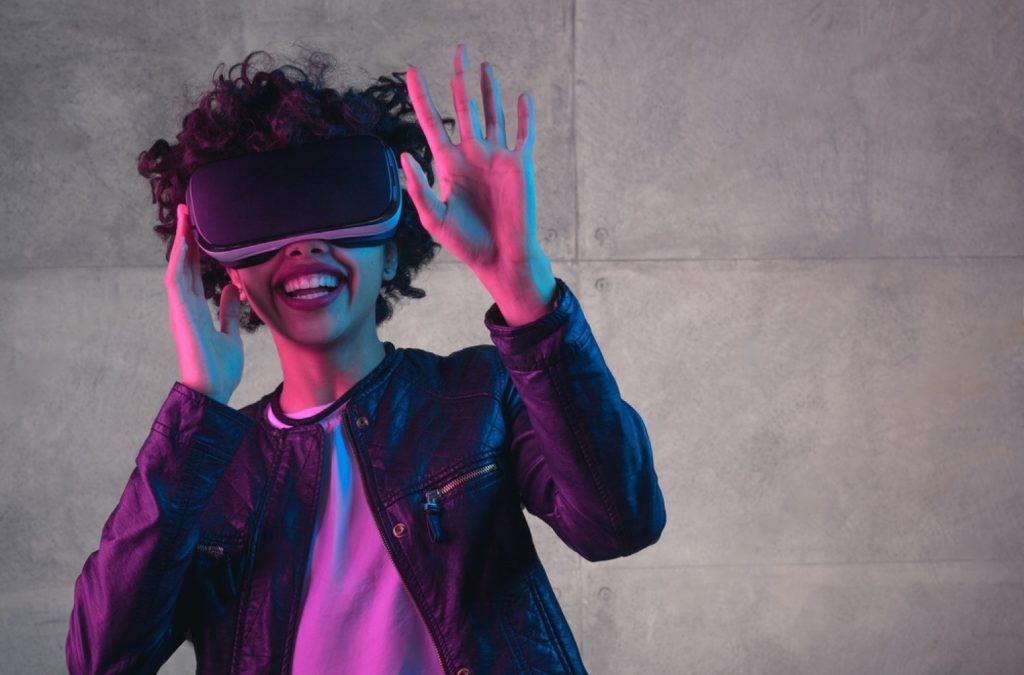What is virtual reality?
Virtual reality (VR) is a computer-generated simulation of a three-dimensional environment that can be interacted with in a seemingly real or physical way by a person using specialized equipment, such as a headset with a screen or gloves fitted with sensors.
How does virtual reality work?
Virtual reality typically involves the use of a headset or other device that displays a 3D environment on a screen in front of the user’s eyes. The headset may also include sensors that track the user’s head movements and adjust the display accordingly, allowing the user to look around and interact with the virtual environment as if they were physically present. Some VR systems also include hand controllers or other input devices that allow the user to interact with and manipulate objects in the virtual environment.
What are the different types of virtual reality?
There are several types of virtual reality, including:
- Non-immersive VR: This type of VR does not fully enclose the user in a virtual environment and may not require the use of a headset. Examples include 360-degree videos and interactive web-based VR experiences.
- Semi-immersive VR: This type of VR allows the user to see and interact with the real world to some extent, while also experiencing a virtual environment. Examples include augmented reality (AR) and mixed reality (MR) systems.
- Fully immersive VR: This type of VR completely encloses the user in a virtual environment and requires the use of a headset or other specialized equipment.
What are the applications of virtual reality?
Virtual reality has a wide range of applications, including:
- Entertainment: VR can be used for gaming, movie-watching, and other forms of entertainment.
- Education and training: VR can be used to teach skills and provide immersive learning experiences in a variety of fields, such as medicine, aviation, and military training.
- Therapy: VR has been used to treat phobias, anxiety, and post-traumatic stress disorder (PTSD).
- Research: VR can be used to conduct experiments and gather data in fields such as psychology and neuroscience.
- Design and visualization: VR can be used to design and visualize products and environments, such as buildings and vehicles.
What equipment is needed for virtual reality?
The specific equipment needed for virtual reality depends on the type of VR system being used. Non-immersive VR experiences may only require a device with a screen, such as a smartphone or tablet, while fully immersive VR experiences may require the use of a headset, hand controllers, and other specialized equipment. Some common VR headsets include the Oculus Rift, the HTC Vive, and the PlayStation VR.

Is virtual reality safe?
Virtual reality is generally considered safe as long as it is used responsibly. However, some people may experience motion sickness or other forms of discomfort when using VR, particularly if they have pre-existing conditions such as epilepsy or are prone to motion sickness. It is also important to follow the manufacturer’s instructions and take breaks as needed to avoid overuse or fatigue.
Can virtual reality be used for teleconferencing or remote meetings?
Yes, virtual reality can be used for teleconferencing or remote meetings. VR headsets and other equipment can be used to create a virtual conference room or meeting space where people from different locations can come together and interact in real time. This can be particularly useful for remote teams or for people who need to attend meetings but cannot be physically present.
Can virtual reality be used for socializing or interacting with other people?
Yes, virtual reality can be used for socializing and interacting with other people. Some VR systems have social features that allow users to communicate with each other using voice or text chat, or to join virtual spaces where they can participate in activities together, such as games or virtual events.
Is virtual reality expensive?
The cost of virtual reality can vary widely depending on the type of equipment and experience being purchased. Non-immersive VR experiences, such as those using a smartphone or tablet, may be relatively inexpensive, while fully immersive VR systems can be more expensive and may require the purchase of additional equipment, such as hand controllers or sensors.
How do I get started with virtual reality?
To get started with virtual reality, you will need to choose a VR system that meets your needs and budget. This may require research and comparison of different products and features. Once you have a VR system, you can start exploring and trying out different VR experiences and applications. Some VR systems come with a selection of pre-installed experiences, while others allow you to download or purchase additional experiences from an online store or marketplace.
Can virtual reality be used for exercise or physical activity?
Yes, virtual reality can be used for exercise or physical activity. Some VR systems include physical components or challenges that require the user to move or perform certain actions in order to progress or complete tasks. For example, VR games may require the user to move their body in order to dodge obstacles or attack enemies, or VR fitness applications may provide guided workouts or challenges that involve physical movements.
Can virtual reality be used for relaxation or meditation?
Yes, virtual reality can be used for relaxation or meditation. Some VR experiences are designed to be calming and immersive, and can be used to help users relax and unwind. There are also VR meditation and mindfulness applications that guide users through relaxation and mindfulness exercises.
Can virtual reality be used for travel or exploration?
Yes, virtual reality can be used for travel or exploration. VR experiences can transport users to different locations around the world or even to other planets, allowing them to explore and experience new places without leaving their home. VR travel and exploration experiences may include realistic environments, historical landmarks, and other points of interest.
Can virtual reality be used for education or learning?
Yes, virtual reality can be used for Education and learning. VR experiences can provide immersive and interactive learning environments that can be used to teach a wide range of subjects, from history and science to art and language. VR can also be used to provide hands-on training and simulations for various fields, such as medicine, aviation, and military training.
Can virtual reality be used for therapy or rehabilitation?
Yes, virtual reality can be used for therapy and rehabilitation. VR can be used to provide exposure therapy for people with phobias or anxiety disorders, or to help people with physical injuries or disabilities to regain function and mobility. VR therapy and rehabilitation experiences may involve virtual exercises, simulations, or other interactive activities that are designed to help users progress and improve.

Are there any potential drawbacks or limitations to using virtual reality?
Some potential drawbacks or limitations to using virtual reality include:
- Cost: VR systems and experiences can be expensive, and may require the purchase of additional equipment or accessories.
- Compatibility: Some VR systems may only be compatible with certain devices or operating systems, or may require specific hardware or software configurations.
- Accessibility: Some VR experiences may not be accessible to users with disabilities, or may require special adaptations or assistive technologies.
- Comfort: Some people may experience motion sickness or other forms of discomfort when using VR, particularly if they have pre-existing conditions such as epilepsy or are prone to motion sickness.
- Limited content: While the selection of VR experiences and applications is growing, it is still relatively small compared to other forms of media or entertainment.
Can virtual reality be used for marketing or Advertising?
Yes, virtual reality can be used for marketing and advertising. VR can provide a unique and immersive experience for consumers and can be used to showcase products, services, or experiences in a way that is engaging and memorable. VR marketing and advertising campaigns may involve the use of VR experiences or events, or the incorporation of VR elements into traditional advertising materials.
Can virtual reality be used for art or creative expression?
Yes, virtual reality can be used for art and creative expression. VR can provide a platform for artists and creators to experiment with new forms of media and storytelling, and can be used to create immersive and interactive art installations or exhibitions. VR art and creative expression may involve the use of VR experiences, games, or other interactive applications.
Can virtual reality be used for business or productivity?
Yes, virtual reality can be used for business and productivity. VR can be used to facilitate remote meetings and collaboration, to train employees, or to conduct virtual presentations or demonstrations. VR can also be used to create virtual work environments or to simulate real-world scenarios for business simulations or planning.
Can virtual reality be used for health or wellness?
Yes, virtual reality can be used for health and wellness. VR can be used for therapy and rehabilitation, as well as for exercise and physical activity. VR experiences or applications that focus on relaxation, mindfulness, or stress management may also be beneficial for overall health and wellness.

Your article helped me a lot, is there any more related content? Thanks!
Thanks for sharing. I read many of your blog posts, cool, your blog is very good.